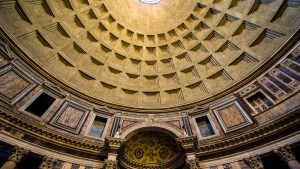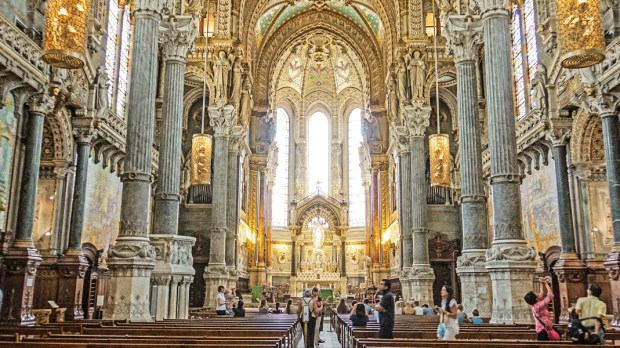Would you describe your parish church as beautiful? Breathtaking? Unforgettable? Do you wish you had more time to explore its treasures? If the answer is “No,” do you wish it could be “Yes”? More important: Does it really matter whether your parish church is beautiful?
A wise Jesuit told me, “The presence of Catholic art in the home doesn’t prove anything but it says a lot; the absence of Catholic art in the home doesn’t prove anything, but it says a lot.” That’s true of Catholic homes and it’s true of Catholic parishes. Yet beauty (or its absence) not only “says a lot”—it does a lot. Beautiful arts nourish the soul even as they prompt us to hunger for Heaven, where Beauty itself resides.
I think that our sick world and wounded Church are so because our need for beauty has been neglected. Philosopher Roger Scruton observes: “Beauty is vanishing from our world because we live as though it did not matter.” Consequently, beautiful churches are rarely constructed and the ones we have are often forgotten: “The great French cathedrals, so full of beauty and interest, are now like whales washed up on an alien shore, the faith that built them a flickering light.” (Dr. James A. Patrick)
What are we to do? Let’s start by answering objections to the reacquisition of beauty in our churches. “Great churches cost money—money that could be used for caring for the poor!” True. But don’t the poor have a need for beauty also? Shall we feed bodies but not souls? And let’s not forget that in the United States, many of the great cathedrals were built with the pennies (and labor) of poor immigrants who wanted to translate the glories of their Catholic heritage from Europe to America. Were they wrong to be so generous?
Beauty needn’t require material cost
There are forms of beautiful adornment available for our churches that cost little or no money. One example is music. We don’t necessarily require an orchestra, an operatic choir, and a 10,000-pipe organ for beautiful music in our churches. Catholicism has a treasury of sublime sacred music, simple to sing, and requiring no instruments. Can’t we afford some sheet music? To parish music directors, I ask: Are you morally certain that for the love of neighbor and the greater glory of God, you have availed yourself of the very best of Catholic sacred music?
Another form of beauty all our parishes desperately need that costs nothing is good preaching. To my brothers who are ordained to preach, I ask: Are you morally certain that the homily you will give this Sunday is marked by the True, the Good and the Beautiful? Will there be any evidence in your homily that for the love of neighbor and the greater glory of God you invested your best efforts, your education and prayer, a dedication to craft? Teaching rhetoric, I require students to begin by reciting poetry: “You must learn to enjoy how words taste. You must first enter the story yourself before you lead others there. Your words are more likely to be credible and memorable if their form and content reveal them to be a labor of love.”
My brothers ordained to preach: Do we strive to offer homilies that reasonable and sensitive people would find to be beautiful? Does that matter to us? We aren’t obliged to become Fulton Sheen or St. John Chrysostom, but are we not obliged to craft homilies that can be seen as acts of worthy worship?
If you’ve ever witnessed the
at Arlington National Cemetery, there is no denying that something solemn and important is happening. And there is no denying that those responsible for the Changing of the Guard believe that this is the most important event of their lives. Discipline, sacrifice, devotion, precision, humility and reverence mark every aspect of the ceremony. It can’t help but inspire awe. (If you watch the video, you will notice that no participant slouches, wears polyester or sneakers, or looks like he can’t wait to get this over with.)An awful lack
What about the churches that we’ve built—especially recently? Would the art and architecture, music, furnishings, vestments, vessels—and especially our behavior—immediately inspire awe? Could you imagine a child entering your parish church for the first time, looking around in wide-eyed wonder, and gasping, “God lives here!”
True love demands that we offer our best to the beloved. Can we have a civil conversation about whether we are offering our best to God? And dare we have an examination of conscience about whether we are offering our best to God?
When I write next, I will speak of the challenge of childrearing in a hostile culture. Until then, let’s keep each other in prayer.
You can listen to Fr. McTeigue discuss this column with John Harper of the “Morning Air” radio program, here.

Read more:
What is “contemplative architecture?”

